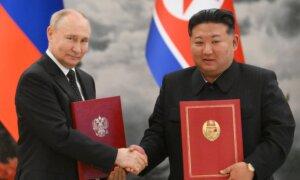Trump threatened to raise tariffs on China-made goods to 150–200 percent if Xi decides to besiege Taiwan.
Former president Donald Trump said he “wouldn’t have to” use military force against a China blockade of Taiwan because Chinese communist leader Xi Jinping respects him and “knows I’m [expletive] crazy.”
A blockade to cut off the trade routes of the self-governed island, to cause natural resource depletion and panic among the Taiwanese, is a tactic that the Chinese Communist Party (CCP) could deploy in an attempt to force Taiwan to surrender to its governance.
The former president’s comment regarding not using military force aligns with most Americans.
The think tank also reported that Americans prefer that Taiwan maintain its status quo over seeking independence or unification with the mainland. Americans support Taiwan’s inclusion in international organizations, arming and providing other supplies to Taiwan, but not sending U.S. troops to the island.
Vice President Kamala Harris said in September 2022 that the United States would “continue to oppose any unilateral change to the status quo” and “continue to support Taiwan’s self-defense, consistent with our long-standing policy.”
Trump commented on the issue amid rising cross-strait tensions.
China’s People’s Republic of China (PRC) and Taiwan’s Republic of China (ROC) celebrated their respective national days on Oct. 1 and Oct. 10. On Oct. 5, days before Taiwan’s National Day, Taiwan President Lai Ching-te said that the PRC had just celebrated its 75th birthday, while the ROC was approaching 113 years old.
After Lai reaffirmed Taiwan’s sovereignty, Beijing responded with a large-scale “joint-sword 2024-B” drill four days later. Compared to the May 23 “joint-sword 2024-A” drill, which was conducted in response to Lai’s inauguration, the Oct. 14 exercises mentioned “blockade on key ports and areas” as a focus for the first time.
Yao Cheng, a U.S.-based former Chinese Navy lieutenant colonel, said the CCP has been working on its Taiwan blockade contingency plan since the late 1980s.
The “joint sword 2024-B” exercise lasted 13 hours and didn’t involve firing any munitions. According to Yao, the drill was a rehearsal for quickly moving the People’s Liberation Army’s (PLA) army, navy, air force, and rocket force to planned spots to lock down Taiwan.
This response from the United States wasn’t enough, according to Craig Singleton, a senior fellow at the Foundation for Defense of Democracies, a Washington-based research institution.
On Oct. 15–16, Xi visited Fujian Province, the mainland’s coastal area that faces Taiwan. There were no public reports about him visiting the navy of the Eastern Theatre Command that is stationed there.
On Oct. 17, he visited a rocket force missile brigade in Anhui Province and asked them to strengthen China’s “strategic deterrence and combat capability.”
Lily Zhou contributed to this report.
Original News Source Link – Epoch Times
Running For Office? Conservative Campaign Consulting – Election Day Strategies!


